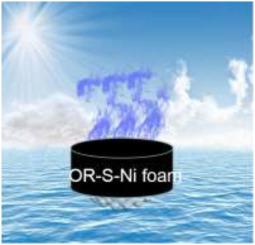当前位置:
X-MOL 学术
›
Sol. Energy Mater. Sol. Cells
›
论文详情
Our official English website, www.x-mol.net, welcomes your
feedback! (Note: you will need to create a separate account there.)
Functional oil-repellent photothermal materials based on nickel foam for efficient solar steam generation
Solar Energy Materials and Solar Cells ( IF 6.3 ) Pub Date : 2020-08-01 , DOI: 10.1016/j.solmat.2020.110574 Shujing Zhao , Lihua Chen , Chuantao Zhang , Qi-Meige Hasi , Lu Zhang , Xiaofang Luo , An Li
Solar Energy Materials and Solar Cells ( IF 6.3 ) Pub Date : 2020-08-01 , DOI: 10.1016/j.solmat.2020.110574 Shujing Zhao , Lihua Chen , Chuantao Zhang , Qi-Meige Hasi , Lu Zhang , Xiaofang Luo , An Li

|
Abstract The production of fresh water by means of solar steam generation has emerged as one of frontier technologies for addressing the global water shortage issue. Here, we report the preparation of new photothermal materials by chemical modification of nickel foam with sulfur via a simple hydrothermal method for solar steam generation. The generation of nano nickel wire on the surface of skeleton of nickel foam by sulfur treatment could construct a much more dense network with hierarchical porous structure and hydrophilicity, which significantly enhance their light absorption (average 40–50% for untreated nickel foam while 91% for sulfur treated nickel foam (named as S–Ni foam) as well as water transportation. In the way, the as-prepared S–Ni foam possesses a high energy conversion efficiency of 83.6% under 1 kW m−2 irradiation. In view of most of reported photothermal materials which suffer the drawback of lose effectiveness in oily water, the S–Ni foam was further chemically modified with an anionic coordination between sodium perfluorooctanoate (PFO) and poly diallyl dimethyl ammonium (PDDA) chloride to achieve a strong hydrophilic-oleophobic wettability (named as OR-S-Ni foam). Such unique wettability endows the as-resulted OR-S-Ni foam excellent oil-repellent performance, making it possible solar vaporization even in water containing oils or organics contaminates, which should be of significantly technological significance for practical solar steam generation by largely extends its applications range.
中文翻译:

基于泡沫镍的功能性拒油光热材料用于高效太阳能蒸汽产生
摘要 利用太阳能蒸汽发电生产淡水已成为解决全球缺水问题的前沿技术之一。在这里,我们报告了通过简单的水热方法用硫对泡沫镍进行化学改性来制备新的光热材料,用于太阳能蒸汽产生。通过硫处理在泡沫镍骨架表面生成纳米镍线可以构建更致密的网络,具有分级多孔结构和亲水性,显着提高了它们的光吸收(未经处理的泡沫镍平均为 40-50%,而 91%用于硫处理的泡沫镍(称为 S-Ni 泡沫)以及水运输。同时,所制备的 S-Ni 泡沫在 1 kW m-2 辐照下具有 83.6% 的高能量转换效率。鉴于大多数报道的光热材料在油水中失去效力的缺点,S-Ni泡沫进一步通过全氟辛酸钠(PFO)和聚二烯丙基二甲基铵(PDDA)氯化物之间的阴离子配位进行化学改性,以实现强亲水疏油润湿性(命名为OR-S-Ni泡沫)。这种独特的润湿性赋予了由此产生的 OR-S-Ni 泡沫优异的拒油性能,使得即使在含有油或有机物污染的水中也能进行太阳能蒸发,这对于实际太阳能蒸汽产生具有重要的技术意义,大大扩展了其应用范围。用全氟辛酸钠 (PFO) 和聚二烯丙基二甲基氯化铵 (PDDA) 氯化物之间的阴离子配位进一步化学改性 S-Ni 泡沫,以实现强的亲水疏油润湿性(称为 OR-S-Ni 泡沫)。这种独特的润湿性赋予了由此产生的 OR-S-Ni 泡沫优异的拒油性能,使得即使在含有油或有机物污染的水中也能进行太阳能蒸发,这对于实际太阳能蒸汽产生具有重要的技术意义,大大扩展了其应用范围。用全氟辛酸钠 (PFO) 和聚二烯丙基二甲基氯化铵 (PDDA) 氯化物之间的阴离子配位进一步化学改性 S-Ni 泡沫,以实现强的亲水疏油润湿性(称为 OR-S-Ni 泡沫)。这种独特的润湿性赋予了由此产生的 OR-S-Ni 泡沫优异的拒油性能,使得即使在含有油或有机物污染的水中也能进行太阳能蒸发,这对于实际太阳能蒸汽产生具有重要的技术意义,大大扩展了其应用范围。
更新日期:2020-08-01
中文翻译:

基于泡沫镍的功能性拒油光热材料用于高效太阳能蒸汽产生
摘要 利用太阳能蒸汽发电生产淡水已成为解决全球缺水问题的前沿技术之一。在这里,我们报告了通过简单的水热方法用硫对泡沫镍进行化学改性来制备新的光热材料,用于太阳能蒸汽产生。通过硫处理在泡沫镍骨架表面生成纳米镍线可以构建更致密的网络,具有分级多孔结构和亲水性,显着提高了它们的光吸收(未经处理的泡沫镍平均为 40-50%,而 91%用于硫处理的泡沫镍(称为 S-Ni 泡沫)以及水运输。同时,所制备的 S-Ni 泡沫在 1 kW m-2 辐照下具有 83.6% 的高能量转换效率。鉴于大多数报道的光热材料在油水中失去效力的缺点,S-Ni泡沫进一步通过全氟辛酸钠(PFO)和聚二烯丙基二甲基铵(PDDA)氯化物之间的阴离子配位进行化学改性,以实现强亲水疏油润湿性(命名为OR-S-Ni泡沫)。这种独特的润湿性赋予了由此产生的 OR-S-Ni 泡沫优异的拒油性能,使得即使在含有油或有机物污染的水中也能进行太阳能蒸发,这对于实际太阳能蒸汽产生具有重要的技术意义,大大扩展了其应用范围。用全氟辛酸钠 (PFO) 和聚二烯丙基二甲基氯化铵 (PDDA) 氯化物之间的阴离子配位进一步化学改性 S-Ni 泡沫,以实现强的亲水疏油润湿性(称为 OR-S-Ni 泡沫)。这种独特的润湿性赋予了由此产生的 OR-S-Ni 泡沫优异的拒油性能,使得即使在含有油或有机物污染的水中也能进行太阳能蒸发,这对于实际太阳能蒸汽产生具有重要的技术意义,大大扩展了其应用范围。用全氟辛酸钠 (PFO) 和聚二烯丙基二甲基氯化铵 (PDDA) 氯化物之间的阴离子配位进一步化学改性 S-Ni 泡沫,以实现强的亲水疏油润湿性(称为 OR-S-Ni 泡沫)。这种独特的润湿性赋予了由此产生的 OR-S-Ni 泡沫优异的拒油性能,使得即使在含有油或有机物污染的水中也能进行太阳能蒸发,这对于实际太阳能蒸汽产生具有重要的技术意义,大大扩展了其应用范围。











































 京公网安备 11010802027423号
京公网安备 11010802027423号